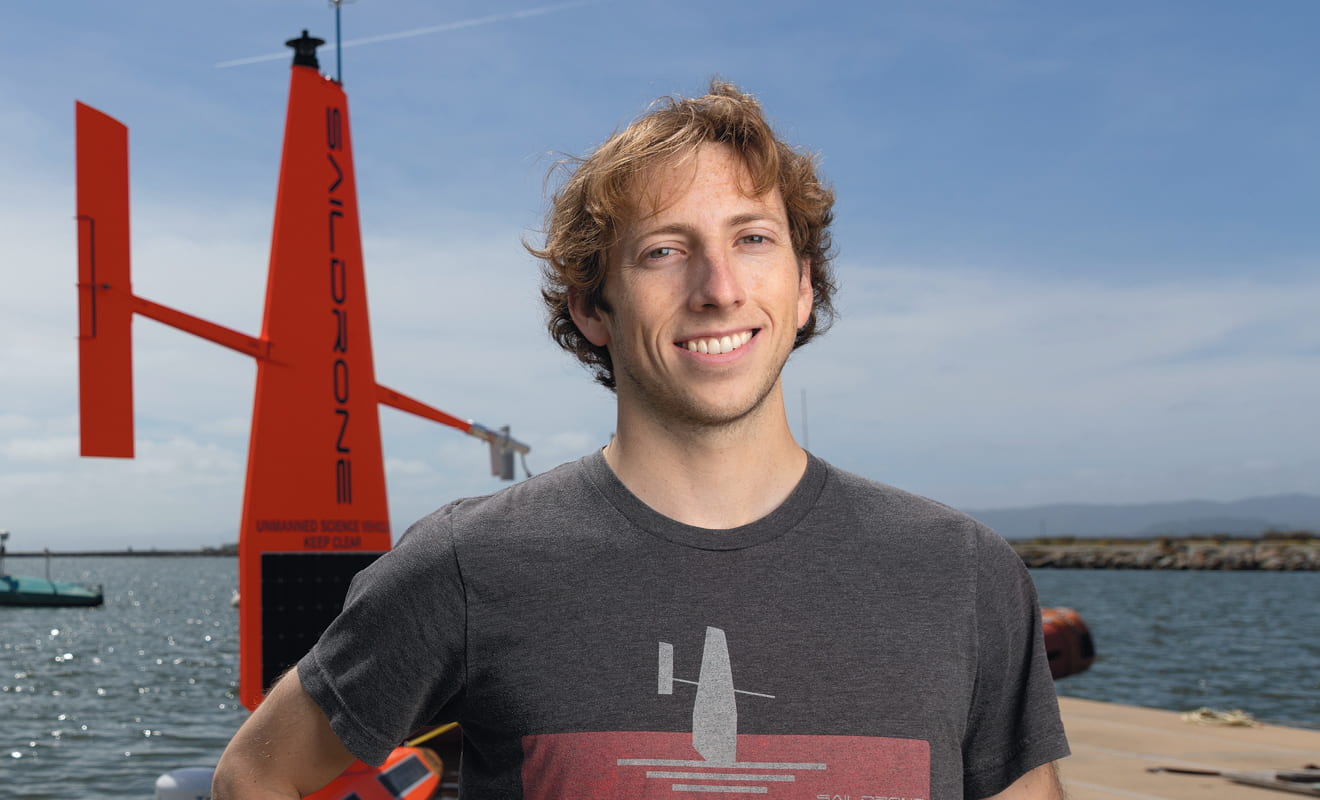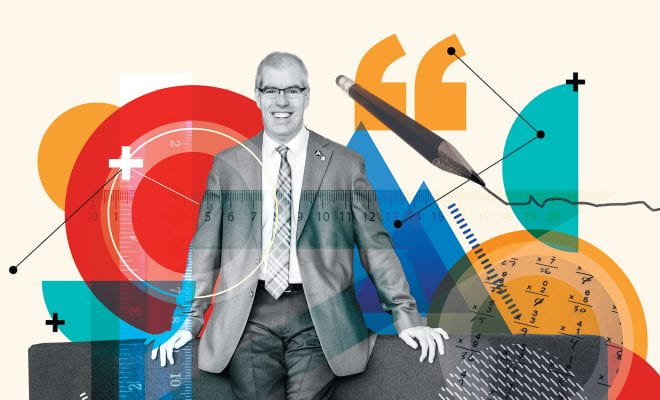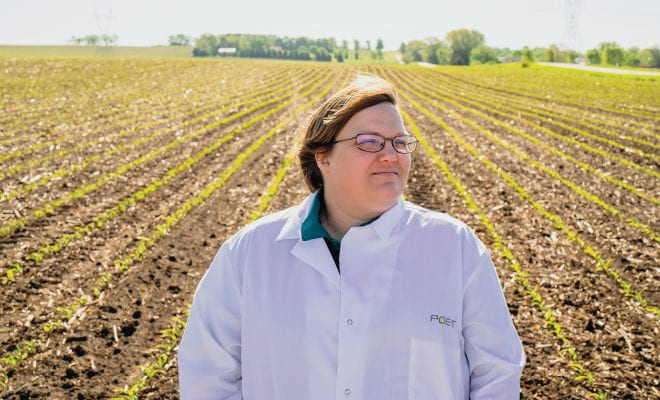After his sophomore year, Brown landed a gem of a summer internship, “a total dream-come-true moment,” at Scaled Composites, an innovative aircraft manufacturer in the Mojave Desert. There he met actual test pilots and got a taste for what such a career might entail—both the good and the bad. “Out in the middle of the desert, it’s pretty barren,” says Brown, who grew up surfing and enjoying coastal life in New Hampshire and Maine. “You really have to commit to the aviation lifestyle and work your way up the ladder for that to be worth it.”
The Saildrone manufacturing facility is abuzz with activity on a balmy late-March day, its huge open doors letting in the breeze from nearby San Francisco Bay. Mechanical engineer Casey Brown ’16 is giving a tour of the gigantic, historic airplane hangar at the former Naval Air Station Alameda on the banks of Seaplane Lagoon. Where 80 years ago workers assembled aircraft for the U.S. war effort, now more than 150 Saildrone employees are building uncrewed surface vehicles (USVs) designed for long-range data collection and surveillance missions in the world’s vast oceans.
Two sets of 23-ft. Explorer drone fleets—the smallest of Saildrone’s three USV models—are lined up like soldiers on elevated racks that expose their sleek keels. The bright orange hulls resemble oversized sea kayaks, but instead of space for human paddlers, high-tech sensors and other electronic equipment are stored under solar panel-covered hatches. The hull and keel stabilize a rotating, rigid sail—essentially an airplane wing mounted vertically—that captures wind and solar power for a carbonless, virtually limitless propulsion system. A T-shaped tail mechanism pierces the sail halfway up, the secret sauce for the USV’s remote, autonomous navigation.
CEO Richard Jenkins founded Saildrone to explore ocean frontiers using technology adapted from his successful 10-year quest to set the land-speed record for a wind-powered vehicle. The company’s sailing drones can, among other duties, autonomously map the ocean floor to a depth of 23,000 feet, sail through hurricanes to return data that could improve forecasting, test water quality in the Arctic Ocean, document fish migration patterns, collect carbon data while sailing the Gulf Stream, and serve as the eyes and ears of maritime law enforcement and safety officials.
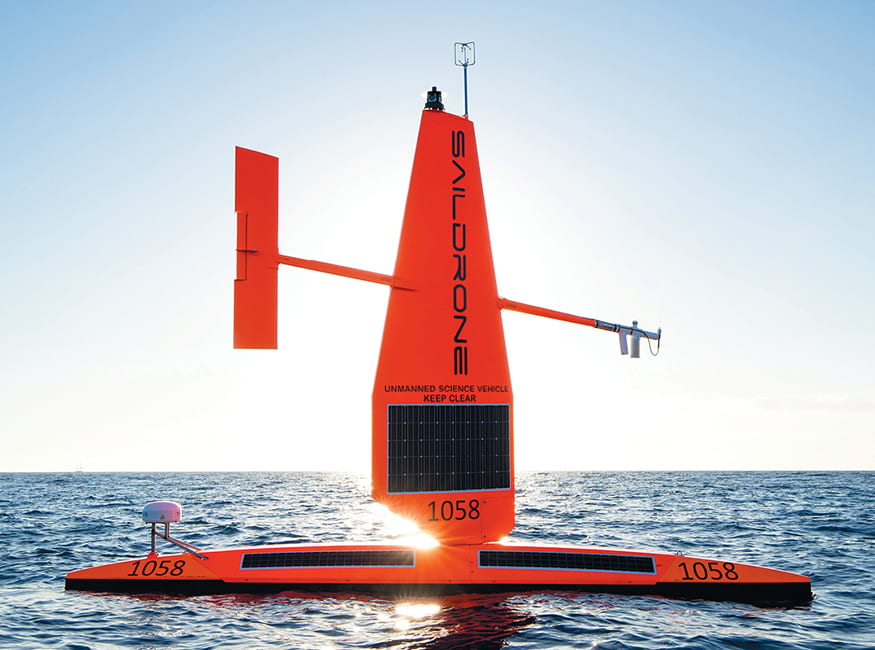
Passing the small reception area, the 28-year-old Brown notes with nostalgia that this was his first shared office when he started helping design and build Saildrone’s early USVs five years ago when the company had only 20 employees. “I don’t get my hands dirty as much now, but I’m still learning new things and that keeps the future exciting,” he says with the air of a seasoned veteran.
Flying Dreams
Brown’s path to a job in the maritime industry was not a straight one, nor one he even imagined as a student at WPI. But he credits his well-rounded education with giving him the confidence and flexibility to pivot in an entirely different direction when he realized his dream of becoming a test pilot or flight test engineer wasn’t going to, well, fly.
“That’s probably the most valuable takeaway from WPI: I left college with a diverse skillset that allowed me to try something new without starting all over again,” says Brown. “It was stressful and uncomfortable, and I felt lost and unsure about where I was headed. But by trusting my intuition and being willing to try something different, it ended up working out.”
He caught the flying bug at age 14, taking lessons at an airport near his home in Eliot, Maine. Although he needed the height from several boat seat cushions to see out the windshield of a vintage Piper J-3 Cub—a 1940s-era plane with no electrical system or radio—it was “by far the most fun thing to fly,” he says.
That’s probably the most valuable takeaway from WPI: I left college with a diverse skillset that allowed me to try something new without starting all over again.
He soloed at 16 and received his pilot’s license at 17, right before starting at WPI. He prepared for the life of a future aviator by majoring in aerospace engineering and building a solid resume of internships and flying experiences. Professor Fred Looft introduced him to the Greater Boston Soaring Club, a group of glider pilots who fly out of the Sterling Airport, just 15 minutes from campus, and Brown learned to fly the club’s tow planes under the tutelage of veteran pilot Ritts Howard.
“It was a classic old-school airport without the security gates and chain link fences found at most small airports these days. It was the perfect place to complement the classroom theory with the practice of actual flight in both powered and unpowered aircraft,” he says. “Being trusted by the club to tow gliders felt like a big deal, and the promise of a career in the field of aviation made all the challenges of schoolwork feel worth it.”
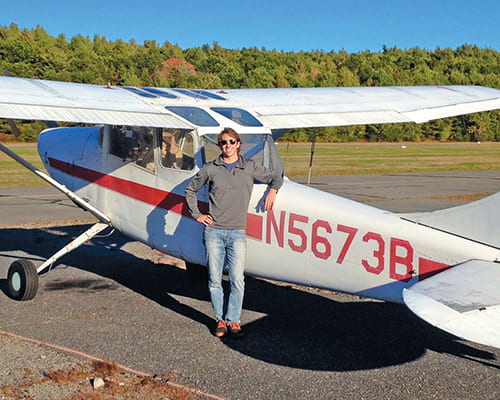
Brown flew glider tow planes at Sterling Airport while a student at WPI.
An Impactful Group Project
When it came time for his Interactive Qualifying Project (IQP), he secured a competitive spot at the Zurich Project Center, where he bonded with Professor Jerry Schaufeld over their shared flying background. Brown’s project team at NTB Interstaatliche Hochschule fur Technik (Interstate University of Technology) built a manual for constructing and operating simple heat pump fruit dryers that were sent to Burkina Faso and other African countries to help farmers preserve their fruit and get it to market.
He loved everything about the experience: the people he worked with, the humanitarian nature of the project, the ability to travel all over Europe on weekends, and—surprisingly—the break from flying.
“My IQP taught me the importance of traveling and being exposed to different cultures and different ways of living. It felt so healthy to get some distance from New England and my aerospace studies and get a taste of how much else there is out there to explore,” he says.
The following summer he returned for a second internship at Scaled Composites, but as he worked toward securing his instrument rating (the next step before a commercial pilot’s license), he began to realize that flying was starting to feel less like a romantic dream and more like an expensive hobby.
“When you’re working on your instrument rating, you’re just staring at gauges and chasing needles and making sure you can fly safely with no visibility. It was a compelling challenge, but more stressful than fun,” he says. “It wasn’t like flying along the coastline on a beautiful summer day in New England. This was like work. The long and uncertain ladder to a test pilot slot didn’t look so appealing anymore.”
After landing my dream internship fairly early in my college career, I never expected to be back at square one after graduation.
To top it off, his Major Qualifying Project (MQP) didn’t go as planned. The team’s entry in a design-build-fly competition was unsuccessful for several reasons, he says, including an unusual design and a strategic error in waiting until too late to test the entry’s flight capability. “Basically, our stuff didn’t work,” he says. “We learned a lot of lessons, but it was a tough experience.”
As his college years came to a close, Brown experienced a profound sense of loss and uncertainty as he realized the dream job in the aviation industry, the one he had worked so hard to secure, really wasn’t for him.
“All of a sudden, my MQP didn’t go well, I didn’t have a job lined up after graduation, I didn’t really know what I wanted to do, and I’m back living with my parents. After landing my dream internship fairly early in my college career, I never expected to be back at square one after graduation,” he says. “I thought, ‘Wow, what just happened?’”
The Pull of the West Coast
As Brown regrouped and plotted his next move, he focused on searching for engineering jobs in the San Francisco area, a place that—in addition to being close to the water and mountains—has a special connection to his family. His father, Nicholas Brown, is a U.S. Navy veteran who was stationed at Naval Air Station Alameda and stayed in the area after discharge. He built fiberglass and carbon fiber rowing shells, worked on tugboats in the bay, and later ended up building and restoring wooden boats. He met and married Alicen, a graphic designer; after the birth of Casey, the family moved to Portsmouth in search of coastal living with more affordable homes and a better public school system. Nicholas continued to work on wooden boats at the Strawbery Banke Museum, and he built a barn with a workshop attached to their house for additional boat work and side projects.
“I was lucky to grow up with creative parents and a workshop full of interesting projects. Whether it was fixing up vintage motorcycles, bicycles, boats, or surfboards, there was always something happening in the shop,” says Casey. “It gave me a perfect space to build models, experiment with remote-controlled aircraft, and get used to working with my hands sculpting wood, foam, or fiberglass. It was an early breeding ground for liking engineering.”
He sent out a flurry of emails to tech companies in the Bay area looking for any job opportunities; Danielle Applestone, founder of the consulting firm SQRLE, was one of the few who replied.
“Some of my best hires ever came from my responding to people who took a leap and really put themselves out there in a cold email. It’s a vulnerable thing to do, and I really want to encourage that kind of action whenever I see it,” says Applestone on why she replied.
She encouraged Brown to not settle for just any job.
“Casey had done a lot of projects on his own steam,” she says. “He is a builder, not just a design-on-the-computer engineer. People who have the drive to complete work from a place of curiosity are always fantastic hires. He also had the guts to reach out to me without knowing me, and it was clear that he is a loving and empathetic person. I knew that with all those ingredients, I could introduce him to leaders in my network and he would be valuable to anyone who hired him.”
One of those connections was at Saildrone, and Brown was soon on a flight out to the West Coast for an interview. The fact that the company was located on a former base where his father was once stationed—in a city where his parents first met—seemed like kismet.
Saildrone hired him as a CAD (computer-aided design) engineer, essentially a junior mechanical engineer. “The job was perfect because it involved doing a bunch of different things,” he says. “They needed scrappy young engineers who were willing to do anything. And they turned me loose to learn all kinds of skills.”
His welding skills, not great to begin with, improved quickly. Under the direction of a more experienced engineer, he learned a variety of manufacturing methods, such as manual machining and laying up fiberglass in molds, while also constructing infrastructure for the shop and designing and installing parts for the drones.
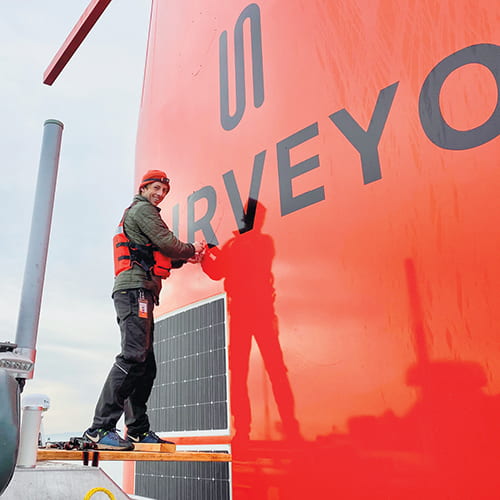
Brown works on the largest of the Saildrone models, the Surveyor.
“I’d get to design in CAD from a notebook sketch, walk out of our little office, cut all the steel on a horizontal band saw, lay it out on the floor, and then weld it up. It was a lot of full days being on the shop floor getting my hands dirty, going back to check the CAD, and seeing my designs through to completion,” he says. “It felt like a bigger version of what I’d always done with my dad in our home shop.”
As an early hire, Brown wore many hats out of necessity. “We had no fit-out team, no deployment team, like we do now,” he says. “I would help load the drones into shipping containers and then I’d fly out with a small team to meet them when they reached places like Australia or Alaska.
“We’d work with the local port to unload, assemble, and launch them for deployment. We have designated fit-out and operations teams now that we’ve grown so much, so I’m glad I was here early enough to get a taste of the whole process.”
The newest Saildrone USV is the Voyager, a 33-foot model designed to accommodate larger and more powerful instrument payloads for deep-water mapping, surveillance, and reconnaissance for law enforcement and maritime safety officials. Nearly every component of the new model needed to be redesigned with the intent of production at scale. Other plans call for increased production of the Surveyor, a 72-foot USV that supports deep-water seafloor mapping equipment.
With so much development work in the pipeline, Brown sees continued opportunities to grow professionally. “I’ve always been fascinated by big ships and heavy infrastructure. With the demand for our new, more complex vehicles growing, we may need to outsource parts of the fabrication to bigger shipyards as we scale up,” he says. “I would love to be part of that interface. Working on bigger projects would be exciting.”
Next Challenges
As he hit his five-year anniversary, Brown became eligible for a three-month sabbatical, a common perk in modern start-ups. In May, he returned to Europe for the first time since his IQP—he’d planned to visit his contacts at NTB (now OTS) Interstaatliche Hochschule fur Technik that he’s kept in touch with over the years. After further travels to Africa and Central America, he’ll return to the Alameda area rejuvenated and ready for the next challenge.

“I love Alameda, love the family history, love the maritime arena I kind of accidently found myself in. It feels great to be gaining experience as a more senior engineer,” he says. “There’s still so much to learn about tackling a design problem in the most efficient way.”
He’s also eager to further explore his passion for surfing, both traditional and kiteboarding. He has built several surfboards—one as a pandemic project—and he’s excited to tap the knowledge of some of the former surfboard builders that have been recruited to Saildrone as the company scales up production.
“One of the coolest things about working for a company that’s ocean-focused and environmentally conscious is it seems to attract a great blend of people that have shared interests relating to the work,” Brown says. “A few of these people happen to be high-level surfboard shapers who are happy to share their board design knowledge and tricks for building them. I never thought that I’d become good friends with local surfers and shapers through an engineering job, but it turns out we both want to learn from each other’s backgrounds. It’s given me a growing appreciation for how widely applicable engineering skills are.”
Whether it was fate or happenstance, Brown appreciates his good fortune at finding his current place in the world.
“After being mostly uninterested in boats and sailing growing up, I now find myself working in a boatbuilding facility surrounded by sailors, working on the Naval Air Station where my dad was based when he was my age, often kiteboarding the same beach where he used to windsurf, which is also where my mom and dad first met,” he says. “If someone told me that’s what I was going to be doing after graduating from WPI, I wouldn’t have believed them.”



